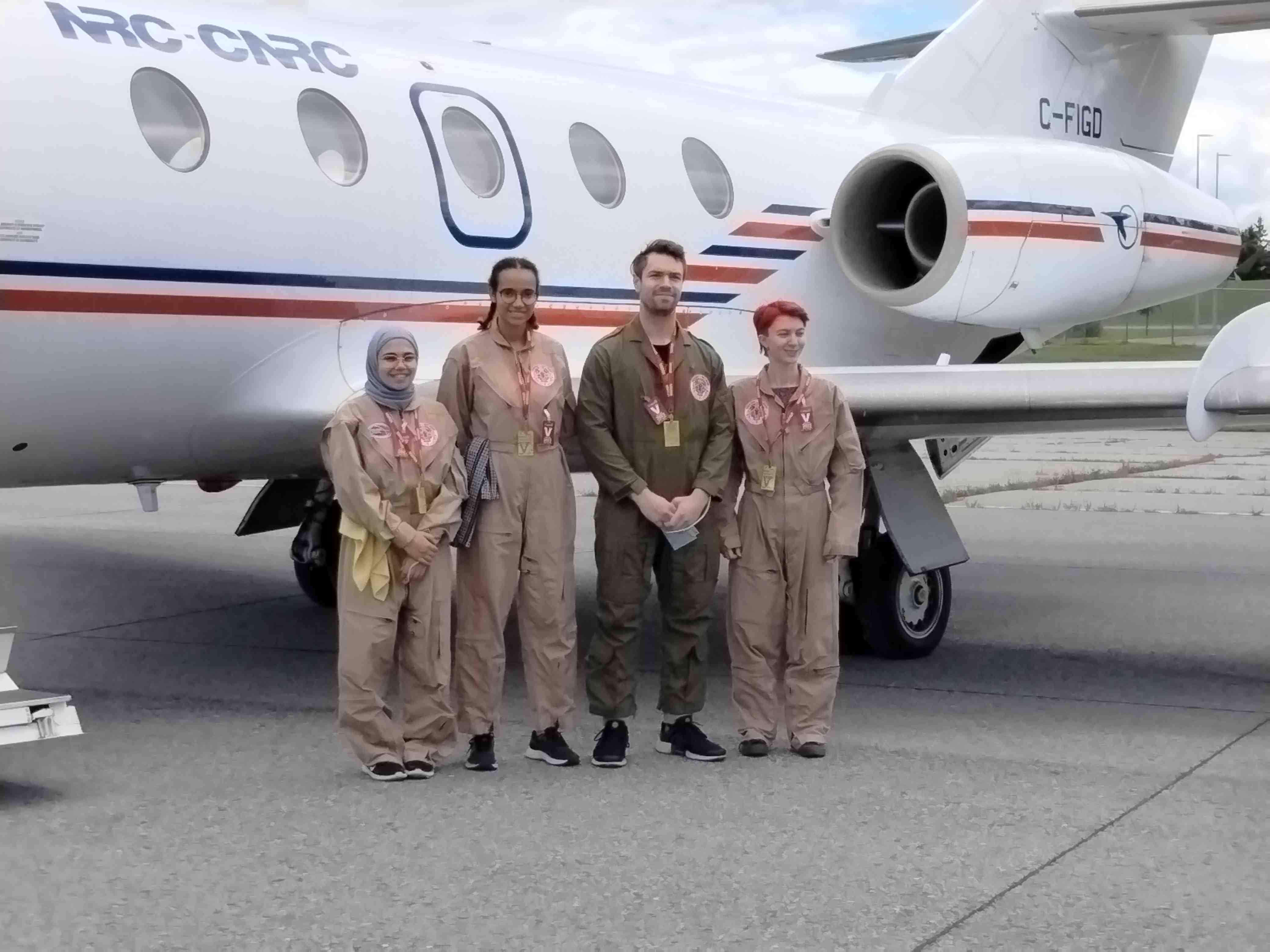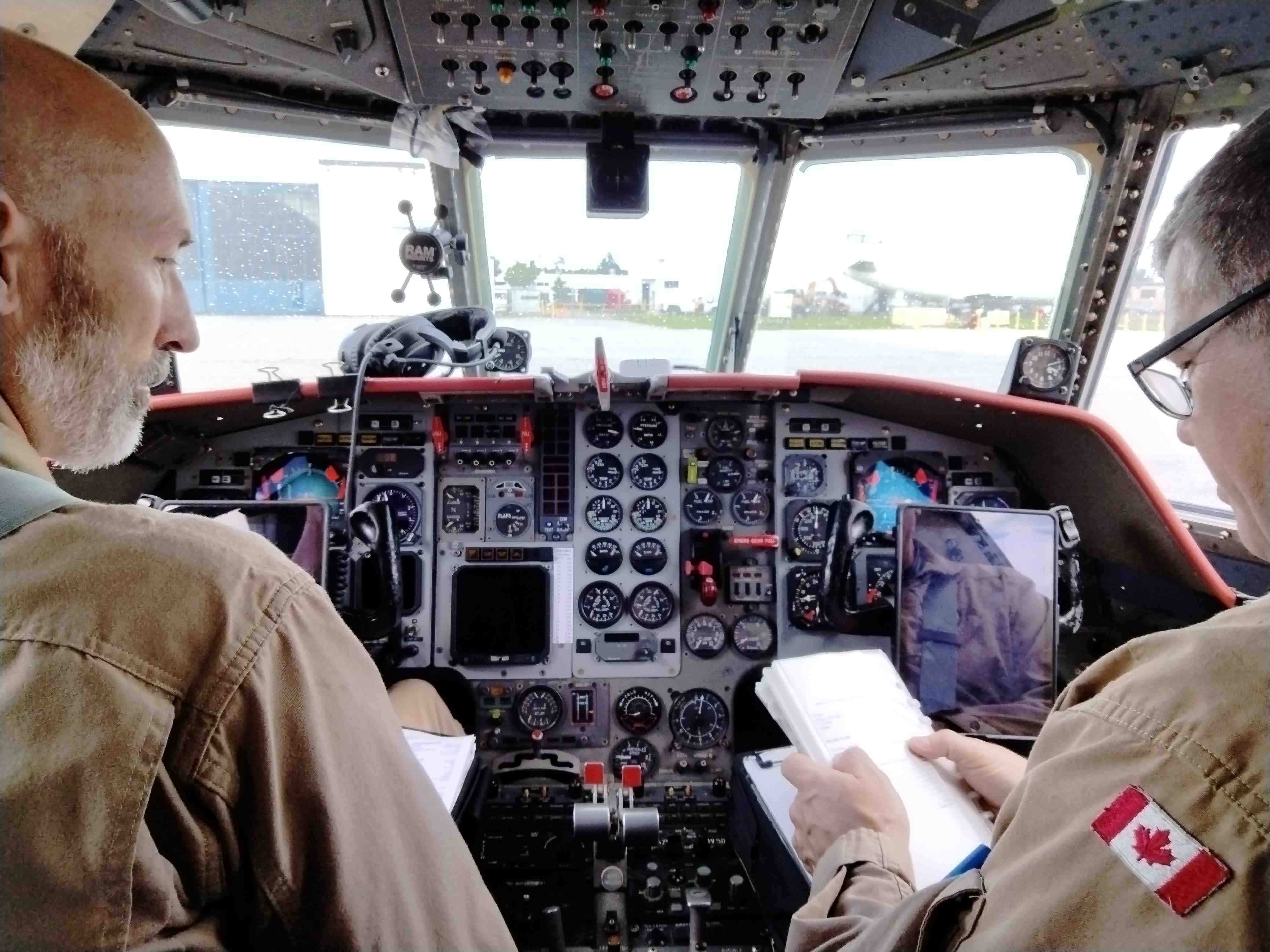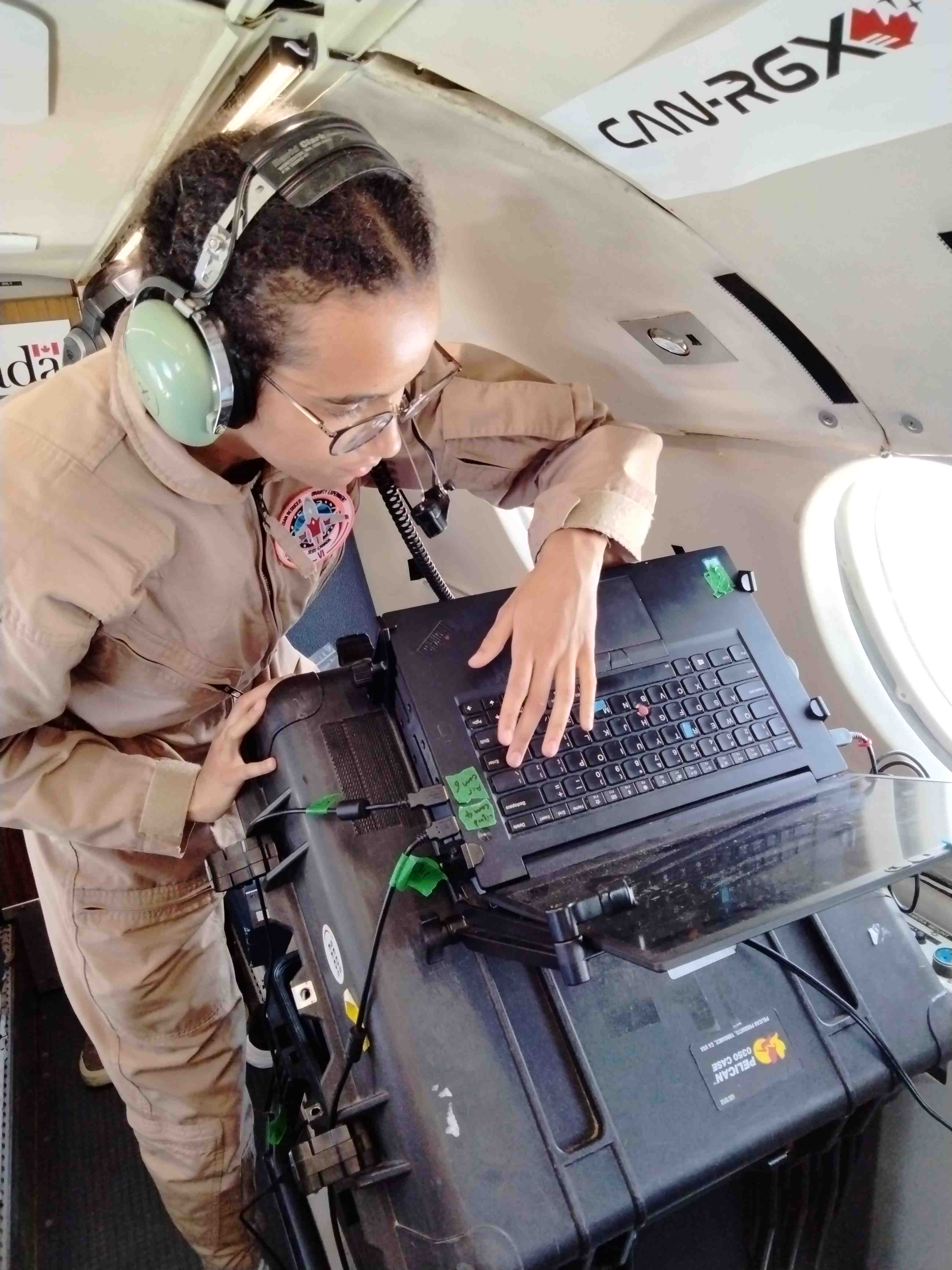I flew weightlessly on a parabolic flight to see incredible student science soar
'The whole thing was just surreal, to see objects in front of you float around, for yourself to float around.'

OTTAWA, CANADA — I was soaring like a superhero.
For about 20 magical seconds at a time, I floated like an astronaut during a special plane flight meant to simulate the weightlessness people feel in space. National Research Council Canada (NRC) had a set of science experiments on board for students, all taking place in a tiny Falcon 20 business jet.
I flew without gravity during eight brief stretches on my Aug. 1 flight. Among my personal items was an Apollo 13 mission patch; the Hollywood hit movie about the mission was partly filmed in a parabolic aircraft. I saw the movie as a teenager in 1996 and wanted to be an astronaut. This flight brought me a small step closer.
But more important to me was the student science taking place just a few feet away. Two university teams supported by Students for the Exploration and Development of Space (SEDS) Canada and the Canadian Space Agency (CSA) were testing their experiments after a year of hard work. Two other student teams would also take flight before the week was over, all for science.
Many of us have seen parabolic flights for tourists or astronaut training. Larger aircraft like Zero-G's specially modified Boeing 727 or Novespace's Airbus A310 do aerial roller coasters, flying at 30,000 feet (9,000 meters) before falling and rising again.
They do a steep climb that creates double the force of Earth's gravity inside the cabin, before deliberately and safely plunging so that everyone inside floats for less than 30 seconds. These larger aircraft have plenty of room for somersaults, or deploying mobile experiments like rovers.
Breaking space news, the latest updates on rocket launches, skywatching events and more!
Our wee Canadian Falcon 20 offered a slightly different flavor of floating. Our plane climbed and dove just like the larger American and European vehicles, but in a narrow business jet you need to keep seatbelts loosely on lest you bash into something nearby. We also did it at a slightly lower altitude, maxing out at about 20,000 feet (6,100 m).
Related: How do you create lunar gravity in a plane? A veteran zero-G pilot explains
Floating feels like a long rollercoaster fall. I was also in the cockpit jump seat for half of the maneuvers and will never forget the wraparound window view of the brief plunge toward the forested ground. (As for airsickness, I followed NRC advice carefully about keeping my head and gaze still. I fortunately came through the experience well, but eight parabolas felt like enough to me for a first go.)
Parabolic flights like this are quickly becoming essential for astronaut training. As more diverse audiences take to space, we need an infrastructure of ground work to help them get ready. Companies like Zero-G are already seeing more demand from companies like Axiom Space to train forthcoming astronauts. And supporting these spaceflyers must be well-tested science experiments, which also go through rounds of weightlessness in Earth simulations before launching to space.
SEDS Canada, NRC and CSA have a partnership bringing a select few students to the skies under the Canadian Reduced Gravity Experiment Design Challenge (CAN-RGX). If you're a Canadian university student and want to get involved, by the way, new applications open in September on the CAN-RGX website, linked above.
Canada's only parabolic jet program is for research, and as such, it operates under a special flight certificate. All people on board sign a waiver and are there under specific duties; mine was to share the student's work publicly and gather footage.

Canada's National Research Council (NRC) flies parabolas simulating spaceflight microgravity, for science. For a week in August 2023 it brought student researchers along for the ride through SEDS Canada and the Canadian Space Agency (CSA).
Back row, left to right: Benoit Gagnon (CSA), Duff Gowanlock (NRC). Front row, left to right: Zoe Lord (Queen's University), Christian Andrade (Concordia University).

NRC works closely with students to get their experiments ready for parabolic flights. Pictured here at the back of the group are Zoe Lord (left, in black flight suit) and Christian Andrade (to Zoe's right), team members of Concordia University's CRISiS.

Teams of roughly 10 students each were involved, often representing multiple institutions. Pictured here in front of the NRC's Falcon 20 aircraft is Ghada Eldib, mission specialist for the University of Calgary's Graviteam.

Team members for the first NRC parabolic flight of Aug. 1, 2023 walk out to the Falcon 20 aircraft. From left to right:
- Derek (Duff) Gowanlock: Research Flight Test Engineer — National Research Council Canada
- Kassandra Hawes: Mission Specialist — UBC Rocket Payloads Team, University of British Columbia
- Tristan Brown: Mission Specialist — UBC Rocket Payloads Team; University of British Columbia
- Hakiri Diarra: Mission Specialist — Graviteam, University of Calgary
- Ghada Eldib: Mission Specialist — Graviteam, University of Calgary

The NRC Falcon 20 business jet used for parabolic flights. The students on board on Aug. 1, 2023 were (left to right):
- Ghada Eldib: Mission Specialist — Graviteam, University of Calgary
- Hakiri Diarra: Mission Specialist — Graviteam, University of Calgary
- Tristan Brown: Mission Specialist — UBC Rocket Payloads Team, University of British Columbia
- Kassandra Hawes: Mission Specialist — UBC Rocket Payloads Team, University of British Columbia

The student researchers in front of the NRC Falcon 20 parabolic aircraft on Aug. 1, 2023. From left to right:
- Ghada Eldib: Mission Specialist — Graviteam, University of Calgary
- Hakiri Diarra: Mission Specialist — Graviteam, University of Calgary
- Tristan Brown: Mission Specialist — UBC Rocket Payloads Team, University of British Columbia
- Kassandra Hawes: Mission Specialist — UBC Rocket Payloads Team, University of British Columbia

The NRC flight team performs standard cockpit checks before starting the takeoff. Pictured are Perry Comeau (left) and Reagh Sherwood (right).

The research team adjusts experiments during a brief break from parabolas on Aug. 1, 2023. From left to right:
- Ghada Eldib: Mission Specialist — Graviteam, University of Calgary
- Shahrukh Alavi: Flight Test Instrumentation Engineer — National Research Council Canada
- Hakiri Diarra: Mission Specialist — Graviteam, University of Calgary

Hakiri Diarra, mission specialist with the University of Calgary's Graviteam, examining equipment in between parabolic flights on Aug. 1, 2023.

NRC spends a year working with students before their parabolic flights. Overseeing experiments here at left is Derek (Duff) Gowanlock, a research flight test engineer with NRC. Far in background is Ghada Eldib, a mission specialist with the University of Calgary's Graviteam.
Each of the partners has specific roles in the flight. NRC has six airplanes and three helicopters for "all dimensions of research studying the science of flight and controlled flight," NRC's Derek (Duff) Gowanlock, a research flight test engineer, told me before we took off.
Autonomous flight for helicopters, atmospheric research, clean-fuel work and environmental research are other branches of what NRC does in mid-air. One milestone effort happened in 2012, for example, with the world's first biofuelled flight.
"We provide an overall spectrum of capability for Canada's aviation research needs," Gowanlock said, standing beside the Falcon 20 in NRC's hangar, a few hundred feet from the Ottawa International Airport, where conventional commercial flights take off through the day. "We support industry and academia and other government departments."
That's where the student work comes in. CAN-RGX challenges students to create experiments for physical and life sciences. Student mission specialists on board also see their vital signs tracked; it's part of a larger research project to assess the human body's physical and mental response in weightlessness.
On site, one student excitedly showed me a 2020 research paper discussing the role of hands, eyes, lower legs and ankles in what is called "somatosensory performance" in microgravity. (The body's somatosensory system uses brain and body neural structures to create the sensations of touch, body position and temperature; the studies show all this can alter a little in weightlessness, depending on the individual and situation.)
I could also see how invested, professionally speaking, the NRC and SEDS on site were in helping the students get off the ground. (CSA also attended on days I was not there.) These professionals teach a lot of skills that will help in all science work. Additionally, all key professional personnel in the flights review the student research — and work directly with the teams for experiment success.
If an experiment breaks, the students learn alongside the scientists how to patch it up on the spot. If a proposal is too complicated to fly in its full form, the students also learn how to focus on the part of the experiment that matters the most — and modify it.
This year's participants are:
CRISiS (Cardiovascular Resuscitation Identification Simulator in Space, from Concordia University and Queen's University): "This project was to engineer a new class of CPR mannequins to be used as a testing platform that can optimize CPR procedures that can be used for human spaceflight," Zoe Lord, mission specialist and team lead for CRISiS, told Space.com.
Graviteam (University of Calgary): The team is examining microgravity conditions with fluids in capillaries, in which liquids and gases can congeal. "The idea is you can have these channels — we have 30 channels or geometries," team lead Anjali Patadia told Space.com. "Because of the geometries, you can use surface properties and other intrinsic fluid properties to separate fluids, because in space, you don't have buoyancy. So your liquid and your gas bases ... don't automatically separate."
UBC Rocket (University of British Columbia): "Our experiment is a mechanical prototype that's designed to facilitate an experiment working with blood clots," team member Kassandra Hawes told Space.com. "More specifically, we're looking at how — when clots form differently in microgravity — you can break them down using what's called 'thrombolytics.' Thrombolytics are are the drugs traditionally used to treat blood clots."
SpiderSat (University of Alberta): "We are developing a dry adhesive net. It mimics the way that geckos climb on walls, and uses Van der Waals forces (molecular attraction) to attract electrons onto the debris. That will allow us to capture space debris as our end goal," team member Connor McNeill told Space.com.
Louis Burelle, project manager for CAN-RGX at SEDS, is a former microgravity flyer himself under the same program. It's been running since 2016 and will be entering its seventh iteration with the forthcoming 2023-24 campaign.
"There are no other microgravity research efforts for students in Canada, so to that end, we're very proud of that fact," Burelle told Space.com at NRC. "It's also a unique hands-on experience for students to experience research aspects and to build out an experiment from proposal to final flight."
Burelle noted that SEDS often gets comments from NRC and CSA about the quality of the projects that the students deliver. The program positions both students and the space industry alike for good research practice after graduation. "This is the next generation of highly qualified personnel that is sought after by industry, and by research, towards the broader goals of Canadian industry," he said.
For the students, it was also an opportunity to try out science in a fresh environment. "The whole thing was just surreal, to see objects in front of you float around, for yourself to float around," Zoe Lord, mission specialist and team lead for CRISiS, told Space.com by video after the flight campaign concluded. "It's just such a wonderful experience."

Elizabeth Howell (she/her), Ph.D., was a staff writer in the spaceflight channel between 2022 and 2024 specializing in Canadian space news. She was contributing writer for Space.com for 10 years from 2012 to 2024. Elizabeth's reporting includes multiple exclusives with the White House, leading world coverage about a lost-and-found space tomato on the International Space Station, witnessing five human spaceflight launches on two continents, flying parabolic, working inside a spacesuit, and participating in a simulated Mars mission. Her latest book, "Why Am I Taller?" (ECW Press, 2022) is co-written with astronaut Dave Williams.


